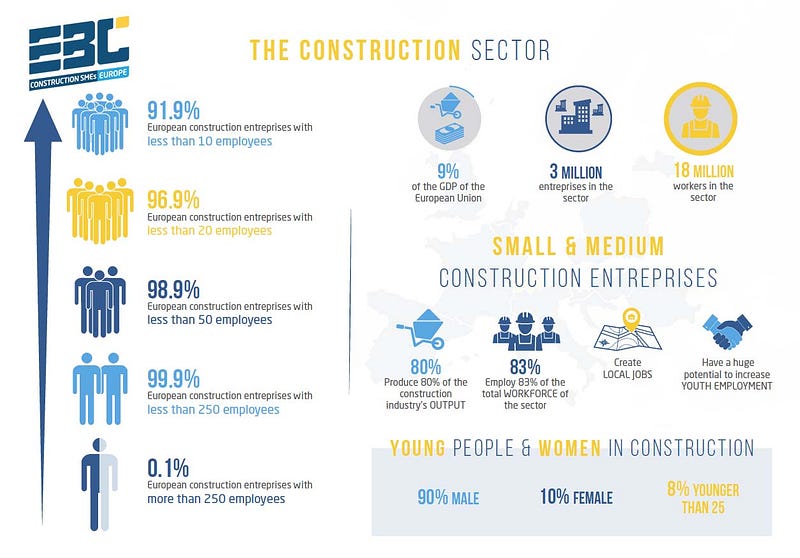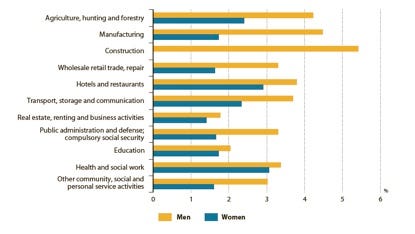The construction sector employs about 18 million people in the workforce contributing to 9% of the total GDP of the European Union.
Even though it is the largest industry employer in the EU, not much has been done and the sector remains haunted by many of its historical issues and problems especially when it comes to health and safety and maintenance management. Ever since construction has been known to be an industry that is never innovative and always resistant to change.

The EU construction landscape
Over the last two decades, productivity growth steadied at 1%, being the lowest among all industries. It was the least digitalised with little investment on research and development. Additionally, safety prevails to be an outstanding concern with high injury and mortality rates.
![]()
Data from Eurostat in 2014 showed that about 3.2 million non-fatal accidents resulted to at least four calendar days of absence from work and 3,739 fatal accidents in 28 EU member countries. More than 1 in 5 of these fatal accidents took place in construction (20.9%).

Causes of accidental death and injury in construction:
- Falls
- Mobile plant and equipment
- Falling material and collapses
- Electrical accidents
- Trips
Ill health from construction result from harsh working conditions and hazardous substances:
- Asbestos
- Heavy lifting
- Noise and vibration
- Chemicals
All EU construction work activities are covered by quality, health, safety, and environmental regulations and guidelines. The most relevant rules are set out here:
- The EU Strategic Framework on Health and Safety at Work
- ISO 9001
- ISO 14001
- OHSA 18001
- The Energy Performance of Buildings Directive
As stakeholder interests are misaligned, structural problems in the industry are also pronounced as demonstrated in flawed contracts and risk-sharing. As construction project complexity increases, inefficiencies in project management become more apparent thanks to fragmentation and non-transparency.
EU construction trends and technologies
There is hope with the rise of startups disrupting the industry with a focus on construction productivity. A few innovative companies are leading the way in digitising and standardising construction processes with an ultimate goal of digitalising construction work models.
Over the past five years, the EU construction industry started embracing innovation, which resulted to a stimulation in construction growth. Current construction trends are mostly tech-related and digitalisation-driven.
Shifting away from pen-and-paper to mobile gadgets
More construction companies are now throwing away their pen-and-paper methods of doing construction processes and shifting to cloud-based mobile apps that make communication transparent and in real time. This is making collaboration more efficient towards more productivity. Mobile and cloud-based software are enhancing the quality of data being collected from the construction sites and significantly improving decision making and productivity.
Related article: The right approach to selecting a QHSE digitalisation tool partner.
The greening of construction
The trend towards eco-friendliness and environmental concern, energy efficiency and related renewable energy sources, is emerging from the ideas of reducing carbon footprints and resource conservation. Even building designs and construction processes are impacted with the EU’s Energy Performance of Buildings Directive, which promotes the improvement of energy performance of buildings. The idea of greening is resulting to smart buildings and intelligent electronics.
A focus on QHSE
Redefining construction QHSE systems by completely digitising processes and digitalising overall methods is currently transforming the quality, health, safety and environmental aspects of construction and finally addressing the historical safety and quality problems.
Additionally, the industry is more and more adopting practices that include software-as-a-service (SaaS), enterprise resource planning (ERP), and bring-your-own-device (BYOD). Early adopters even use data technologies like big data, analytics, machine learning and artificial intelligence (AI), virtual reality (VR), augmented reality (AR), building information modelling (BIM), the internet of things (IoT), geolocation and blockchain.
All these have great applications that will multiply the impact of digitalisation in construction. Collectively, these will enhance productivity, efficiency, logistics, quality, delivery and the overall performance of the construction industry.
Further reading: Construction industry issues that technology adoption can solve.
This article contains excerpts from an ebook called, The Clear and Complete Guide to a Digitised QHSE Organisation. If you want to learn more, head over and download the complete ebook for FREE today!



